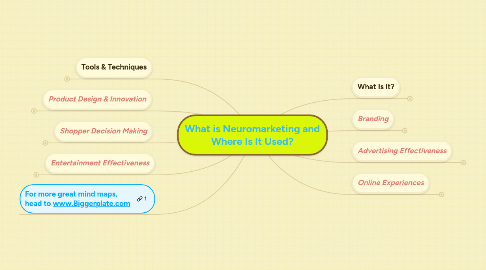
1. Tools & Techniques
1.1. Neuromarketing uses a variety of tools and techniques to measure consumer responses and behavior.
1.1.1. from relatively simple and inexpensive approaches
1.1.1.1. such as eye tracking (measuring eye gaze patterns)
1.1.1.2. analyzing facial expressions
1.1.1.3. and behavioral experiments
1.1.1.3.1. for example, seeing how changes in product displays affect a consumer’s choices
1.1.2. to more complex, sensor-based approaches
1.1.2.1. including biometrics (body signal measures) that measure perspiration
1.1.2.2. respiration
1.1.2.3. heart rate
1.1.2.4. and facial muscle movement (electromyography [EMG])
1.1.2.5. as well as neurometrics (brain signal measures) that measure electrical activity (electroencephalography [EEG]), and blood flow (functional magnetic resonance imaging [fMRI]) in the brain.
2. What Is It?
2.1. The term neuromarketing refers to the use of modern brain science to measure the impact of marketing and advertising on consumers
2.2. For decades, marketers have sought to understand what consumers were thinking, but they’ve relied on traditional techniques
2.2.1. e.g. asking them what they thought in focus groups and surveys.
2.3. Neuromarketing techniques are based on scientific principles about how humans really think and decide, which involves brain processes that our conscious minds aren’t aware of.
2.3.1. When combined with sound experimental designs and procedures, these new techniques provide insights into consumer decisions and actions that are invisible to traditional market research methodologies.
2.4. Neuromarketing is not a new kind of marketing
2.4.1. it’s a new way to study marketing, so it’s part of the field of market research.
2.5. This map outlines six major areas where neuromarketing is being used today
3. Branding
3.1. Brands are ideas in the mind that draw strength from the connections they make.
3.2. Neuromarketing provides powerful techniques for measuring brand associations.
4. Product Design & Innovation
4.1. Neuromarketing can measure consumer responses to product ideas and package designs that are largely automatic, emotional, and outside our conscious awareness.
5. Advertising Effectiveness
5.1. Much advertising impacts us through nonconscious means, even though we don’t think it does.
5.1.1. Neuromarketing explains how.
6. Shopper Decision Making
6.1. Neuromarketing shows how store environments directly influence how shoppers decide and buy, and it’s not a logical process.
7. Online Experiences
7.1. The online world provides new challenges to our old brains.
7.2. Brain science shows the many ways we can be subtly influenced as we go about our online activities.
8. Entertainment Effectiveness
8.1. Entertainment creates experiences in people’s minds that can influence:
8.1.1. attitudes
8.1.2. preferences
8.1.3. actions
